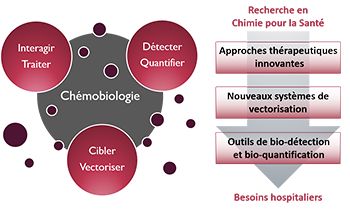Oral Comm
- Projet
-
-
Jean-Luc DECOUT, Antoine FORTUNE, Benjamin BOUCHERLE,
- Titre
-
Discovery of novel tailored F508del-CFTR binder correctors based on 3D structure models of entire CFTR protein for treating Cystic Fibrosis
-
- Auteurs
- Clément Boinot, Mathilde Jollivet Souchet, Brice Hoffmann, Jean-Paul Mornon, Benjamin Boucherle, Antoine Fortuné, Jean-Luc Decout, Pierre Lehn, Isabelle Callebaut, Frédéric Becq
- Edition
- the 11th ECFS Basic Science Conference., At Saint Julians, Malta
- Année
- 2015
- Résumé
- Cystic fibrosis (CF) is an autosomal and recessive disease due to mutations in the gene encoding a chloride ion channel CFTR (cystic fibrosis transmembrane conductance regulator). Deletion of phenylalamine at position 508 leads to the most common mutation, resulting from a mistrafficking of the CFTR protein and its retention in the Endoplasmic Reticulum (ER), abnormal gating of CFTR channel and endocytosis. Numerous small chemicals called CFTR correctors (VX809, SAHA, Corr-4a, iminosugars…) have been shown individually-albeit partially – to restore F508del-CFTR defective trafficking and functionally rescue chloride transport default. Although the mechanism of action of these correctors is still largely unknown, recent evidence suggests direct interaction of VX809 on the first transmembrane domain TMD1 of CFTR. Here, based on models refinement of the open and closed forms of CFTR, we used molecular docking and virtual screening to identify new active molecules able to bind and interact with identified F508del-CFTR pockets. This strategy led to (1) design novel tailored correctors following molecular docking prediction, allow to bind specifically in F508del-CFTR pockets (2) synthetize these putative idealized compounds and (3) test them on the functional rescue of F508del-CFTR. We used our Bioscreen platform using a simple flux test combined to patch-clamp experiments in whole cell configuration on F508del-CFTR cell lines and human airway epithelial CFBE cells to screen these candidates for their potential correction efficacy. Preliminary experiments showed that after 24h of incubation some of these molecules restored the F508del-CFTR response to a cocktail of activators (forskolin + genistein) in CF cells with submicromolar EC50 values. In a second set of experiments, using patch-clamp technique in whole-cell configuration on Hela F508del-CFTR, we tested 24h incubation of these novel correctors in combination with VX809 to investigate putative synergistic effects of two binder correctors on F508del-CFTR rescue. We demonstrated with this combination that the amplitude of the current densities recorded in response to activation was not significantly different compared to incubation with VX809 alone. Our next step will be to test second site suppressor mutations in combination with these novel molecules to investigate putative synergistic effects on F508del-CFTR folding and stability. Results will be presented opening perspectives on the development of new tailored correctors based on 3D structure model of entire CFTR protein to target the root cause of CF.











 Annuaire
Annuaire Contact
Contact Plan d'accès
Plan d'accès ENG
ENG Login
Login



